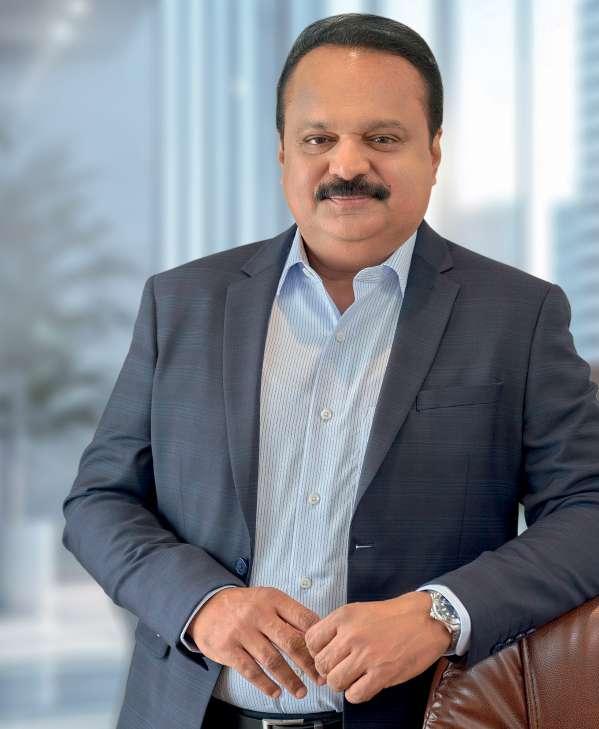

SHIJO K. THOMAS & OXYGEN: BREATHING LIFE INTO DIGITAL INNOVATION
Shri V.P. Nandakumar MD & CEO, Manappuram Finance Ltd


















Shri V.P. Nandakumar MD & CEO, Manappuram Finance Ltd
















Czech carmaker Skoda Auto is preparing to manufacture electric vehicles in India, planning independent investment if a local partner is not found. CEO Klaus Zellmer emphasized India's strategic importance beyond Europe, with Skoda signing an initial $1.7 billion agreement with Maharashtra for EV production and exploring joint ventures with local companies. Meanwhile, its parent company, Volkswagen Group, faces a $1.4 billion tax dispute in India over alleged import misclassification, with potential penalties reaching $2.8 billion. While Zellmer did not comment on the legal case, he reaffirmed Skoda’s commitment to India, leveraging Volkswagen’s EV technology. Despite holding just a 2% market share, Skoda sees growth potential, especially with stricter fuel efficiency norms arriving in 2027. As China and Russia no longer serve as key markets, India has become vital for Skoda’s expansion into Southeast Asia and the Middle East.
“Play by the rules, but be ferocious.”
Phil Knight

State Bank of India (SBI) has decided to halt its plan to raise up to `150 billion through bond sales in the current fiscal year due to persistently high bond yields, despite recent policy rate cuts and liquidity measures by the central bank. Originally set to issue `50 billion in Basel III-compliant additional Tier-I perpetual bonds and `100 billion in 15-year infrastructure bonds, SBI now plans to reassess its funding needs in the new financial year starting April. Rising yields on AAA-rated 10-year corporate bonds—up by 15 basis points since early February 2025—have made market conditions unfavourable. Meanwhile, state-run banks like Bank of India, Punjab National Bank, and Bank of Maharashtra raised `72.52 billion via infrastructure bonds in February, falling short of their targets. SBI last tapped the market in October 2024, raising `50 billion at a 7.98% yield via perpetual bonds.

India CEO Campbell Wilson has warned that the global aircraft shortage, driven by supply chain disruptions at Boeing and Airbus, could continue for another four to five years. Speaking at a Skift event, Wilson cited difficulties in sourcing jet engines, premium-class seats, and fuselage components, hampering Air India’s turnaround under Tata Group ownership. Despite placing an order for 470 aircraft last year, the airline has been forced to extend the use of older jets, increasing maintenance costs and delaying expansion. Delivery delays have affected the entire aviation industry, making leased aircraft harder to obtain. Air India is also uncertain about the arrival of Boeing’s delayed 777X, leading to a pause on further purchases. Boeing continues to face production constraints, including an FAA-imposed cap on 737 MAX output, worsening supply issues for airlines globally. Boeing has yet to comment on its production and delivery challenges.
“Success seems to be connected with action. Successful people keep moving. They make mistakes, but they don’t quit.”
Conrad Hilton

Nadar Malhotra has become the largest shareholder of HCL and the third-richest Indian after receiving a 47% stake from her father, Shiv Nadar, as part of succession planning. Nadar transferred his stake in HCL Corporation and Vama Delhi, giving Malhotra majority control over HCL Corp, Vama, HCL Infosystems, and HCLTech. Following the transfer, she gained voting rights over a 12.94% stake in HCL Infosystems held by Vama Delhi and 49.94% held by HCL Corp. According to Bloomberg Billionaires data, Mukesh Ambani remains India’s richest with $88.1 billion, followed by Gautam Adani at $68.9 billion. Previously ranked third at $35.9 billion, Shiv Nadar stepped down, making way for Malhotra. Vama Delhi holds a 44.71% stake in HCLTech, valued at `186,782 crore. Malhotra, HCLTech’s chairperson since 2020, holds degrees from Northwestern University and the Kellogg School of Management.


British Finance Minister Rachel Reeves is set to confront a £4.4 billion ($5.7 billion) budget deficit, reversing earlier surplus projections due to weaker economic growth and rising interest rates. The Office for Budget Responsibility is expected to slash its 2025 growth forecast, aligning with the Bank of England’s lowered projection of 0.75%. Reeves, preparing for her March 26 budget update, must navigate fiscal rules requiring balanced spending by 2030. Experts caution against deep welfare cuts and suggest tax increases instead, though Prime Minister Keir Starmer and Reeves pledged not to raise major taxes. One potential measure is extending the income tax threshold freeze until 2030. Meanwhile, higher government borrowing costs, influenced by US policies under Donald Trump, further strain Britain’s finances. The Resolution Foundation urges Reeves to take decisive action while protecting lower-income households from economic burdens.

Britain has warned it may trigger the return of UN sanctions to prevent Iran from obtaining nuclear weapons, as Tehran enriches uranium to 60% purity— close to weapons-grade levels. During a closed-door UN Security Council meeting, Western nations argued such enrichment is unnecessary for civilian use, while Iran maintains its program is peaceful. Britain’s deputy UN Ambassador James Kariuki stressed diplomatic measures, including sanctions, to curb Iran’s nuclear ambitions. The US and allies accuse Iran of violating IAEA obligations, while Tehran condemns Washington’s pressure tactics. Meanwhile, China is set to host talks with Russia and Iran to salvage the 2015 nuclear deal (JCPOA), warning against maximum pressure strategies. With the UN resolution on the Iran deal expiring in October, Britain, France, and Germany will soon lose the ability to reimpose sanctions, heightening geopolitical tensions as diplomatic efforts falter.
As the digital revolution swept across Kerala, Oxygen: The Digital Expert has journeyed alongside this transformation, bringing the latest leading digital brands to consumers and fully meeting post-sale customer expectations and aspirations. Over the past 25 years, the company has earned the unwavering trust of over 7 million customers. In an exclusive conversation with Unique Times, CEO Shijo K. Thomas shares insights into the brand’s remarkable journey and its vision for the future.
Tell us about your plunge into the world of business?
After completing my diploma in computer engineering, I worked for two years at a private firm in Ernakulam. However, due to my mother’s medical treatment, I had to resign from my job and return to my hometown, Kanjirappally in Kottayam district in 1999.
At that time, I needed an alternative to my job, and so I started a small business in a 50-square-foot space in Kanjirappally called Ozone Systems, which assembled and sold computers. Since my education and work experience were related to computers, I turned to self-employment in response to my circumstances. In the early days, it was just one staff and I. That was the period when the computer revolution was just beginning. Back then, computers were primarily found in large institutions, and systems for personal use were quite rare.
We imported spare parts for
personal computers and assembled them ourselves before delivering them to customers. Assembling a computer was a time-consuming process, often taking several days. The transition from DOS to Windows had just begun, with Windows 3.1 being the operating system in vogue. Installing an operating system required 31 floppy disks, and loading each disk took several days. If even one floppy disk had fungus, the entire process would get stuck. Assembling a computer was a challenging task back then.
Nowadays, computers come preinstalled with operating systems, making the process much easier. What started as a small venture in Kanjirappally eventually expanded to Kottayam.
What was the inspiration behind the name ‘Oxygen’?
One of the key ideas was to bring in a unique name that had no direct connection with technology and then market and brand it effectively.
Additionally, since our first venture was named Ozone Systems, the rebranding naturally led us to Oxygen. We also considered the chemical transformation from ozone (O3) to oxygen (O2). Moreover, in today’s world, digital products have become as essential as oxygen for people, making the name even more relevant.
“Trust is our hot ticket to success” – How has this philosophy helped shape the growth of the Oxygen Group?
From the very beginning, trust has been our top priority. We place great emphasis on after-sales service. The relationship with a customer starts when they purchase a product, especially electronic goods, and it continues beyond the sale. When computers were not as common in the early days, customers had many doubts about their functionality. It was also the time when the internet was just starting to gain

From the very beginning, trust has been our top priority. We place great emphasis on after-sales service. The relationship with a customer starts when they purchase a product, especially electronic goods, and it continues beyond the sale.
`1,000 crore, having the right system, processes, and a technology-driven backend is crucial. Beyond individuals, if technology is effectively implemented, it can elevate a business to any level.
Secondly, everyone in leadership must have a growth mindset. The moment one starts thinking, “This much is enough,” the growth curve begins to decline. Setting up a growth engine, analysing data, and making necessary adjustments ensures that both innovation and expansion are balanced effectively.
What was the reason behind launching your own TV brand, ‘Oxyview’?
Our deep engagement with customers across our stores helped us realise the market potential for a private-label product. There was a demand for a high-quality television with all essential features at an affordable price.

Everyone in leadership must have a growth mindset. The moment one starts thinking, “This much is enough,” the growth curve begins to decline. Setting up a growth engine, analysing data, and making necessary adjustments ensures that both innovation and expansion are balanced effectively.

In any business, the most important aspect is to execute innovative ideas creatively. This ability is the first and foremost requirement for an entrepreneur. They must be strong enough to face challenges and crises, take the initiative in every situation, and have the adaptability to adjust to changing circumstances. They should also be capable of creating the necessary resources for the business.
Since it is our own brand, we can provide direct service and warranty. Oxyview was created with the vision of making smart technology accessible to the common man. The response and feedback have been overwhelmingly positive, to the extent that demand often exceeds supply.
The success of this product has paved the way for expansion into other home appliances. In the upcoming season, Oxyview air conditioners (ACs) will be launched, followed by small appliances. Additionally, large-scale manufacturing operations are happening in India. The Indian government’s “Make in India” initiative has been highly supportive in this regard. Are there plans to expand Oxygen at the national or international level?
Yes, national expansion efforts are already in progress, and they will be realised soon. However, there are currently no immediate plans for international expansion. What are the essential qualities of an entrepreneur?
In any business, the most important aspect is to execute innovative ideas creatively. This ability is the first and foremost requirement for an entrepreneur. They must be strong enough to face challenges and crises, take the initiative in every situation, and have the adaptability to adjust to changing circumstances.
They should also be capable of creating the necessary resources for the business.
Above all, an entrepreneur must be patient. Success does not come overnight—it requires consistent efforts and perseverance. Many young entrepreneurs and start-ups enter this field thinking, “I can’t work under someone else, so I’ll start my own business.” However, their rise and fall often happen as quickly as fireflies flashing in the dark. Some keep shifting from one venture to another because they lack the patience to endure losses.
In my case, for the first five years, I had no profits—I faced multiple financial setbacks. However, patience and persistence helped me reach where I am today.
Every business typically goes through five stages, known as the “5 S’s”:
1. Struggle – The initial phase involves battling various challenges.
2. Survival – This is when a business begins to manage its expenses.
3. Stability – At this stage, profits start coming in.
4. Success – This phase involves establishing a strong secondline leadership team that manages systems and processes.
5. Scale-up – The final stage, where the business grows beyond the entrepreneur’s direct involvement. What challenges do you
face in running a large retail chain?
With the rise of e-commerce, the retail sector faces an unhealthy level of competition. The market has shifted toward price-based competition, often ignoring customer value.
Previously, factors like after-sales service and customer satisfaction were given priority. However, many consumers are now solely focused on finding the lowest price, neglecting long-term benefits. This trend is problematic because companies that rely only on price cuts will struggle to sustain in the long run, ultimately leading to customer dissatisfaction.
The right approach to competition should involve offering fair pricing while also prioritising after-sales service and overall customer experience.
If Oxygen were to start a new business beyond retail, which industry would you choose?
If we were to launch a new business apart from retail, we would venture into digital product manufacturing. The reason is that digital products have limitless potential in today’s world. Technologies based on Artificial Intelligence (AI) and Robotics are rapidly emerging and transforming daily life. AI is already integrated into various products— smartphones, laptops, and even household appliances.
To keep up with these advancements, we would focus on develop-

ing AI-driven and robotics-based digital products that align with evolving consumer needs. How would you sum up Oxygen’s success in three words?
Our success is built on three fundamental principles:
1. Democracy – Every decision is made through discussions with the team, valuing everyone’s input.
2. Socialism – There is no hierarchy in importance; from the CEO to the sweeper, every team member is treated equally.
3. Secularism – We uphold internal organizational pillars that promote fairness and transparency. Additionally, we prioritise transparency with customers, ensuring high-quality products. From assembling computers in our early days to embracing cutting-edge technologies, we have remained dedicated to keeping the public informed and updated.
Lastly, we believe that wealth is earned from society, so it should be reinvested for the greater good in various ways
regulatory confidence in the sector, ensuring stability and reducing uncertainty for investors and lenders. With these recent developments, banks are likely to lower interest rates to NBFCs. Since banks are the second-largest lenders to NBFCs, this policy shift is likely to enhance liquidity and credit access. It will also be positive for those particularly involved in housing finance, vehicle loans, gold loans, and MSME lending.
The non-banking financial sector remains crucial in India's financial ecosystem by reaching underserved segments where commercial banks have limited access. With a strong presence in industry and retail lending, NBFCs serve as crucial enablers of growth, particularly for businesses and individuals who may not have easy access to traditional banking. With every passing year, the contribution of

NBFCs to GDP and their market share are evidently increasing. The recent policy support and expectations of improving liquidity conditions have further reinforced their resilience, ensuring sustained credit flow to critical segments of the economy. With the Q3 GDP results reflecting momentum and the economy on a positive trajectory, the outlook for both the financial sector and the economy remains promising

Rajesh Nair Partner, Ernst & Young LLP
Communication, a cornerstone of effective leadership, is also significantly enhanced by a leader's EQ. Emotionally intelligent leaders communicate clearly and persuasively, tailoring their messages to resonate with their audience. They possess the knack for non-verbal cues, enabling them to convey and read emotions more accurately.
In today's rapidly evolving business environment, the traditional metrics of intelligence and technical expertise, encapsulated in the concept of Intelligence Quotient (IQ), are no longer sufficient for effective leadership. Increasingly, Emotional Quotient (EQ), or emotional intelligence, is recognized as a crucial element in distinguishing great leaders from merely good ones. Understanding and leveraging EQ can lead to more effective communication, improved team dynamics, and ultimately, more sustainable business success.
Emotional Quotient refers to the ability to identify, understand, manage, and utilize emotions—both one's own and those of others—in positive and constructive ways. This capability is vital in a business context for several reasons, the most significant being enhanced interpersonal relationships. Leaders with high EQ can more accurately perceive how their employees feel, understand the underlying reasons for these emotions, and respond to them empathetically. This empathic approach not only fosters a more harmonious
workplace but also contributes to a culture of trust, wherein team members feel heard and valued.
Moreover, leaders possessing a high EQ are adept at self-regulation, effectively managing their own emotions and reactions in various situations. This is particularly important in high-stakes or stressful scenarios, where the ability to remain calm and focused can influence the overall morale and performance of the team. By modelling composure and resilience, leaders inspire confidence and stability, encouraging their teams to emulate these behaviours.
In addition, leaders with strong emotional intelligence demonstrate greater adaptability and problemsolving skills. They are open to feedback, willing to adjust their strategies, and capable of acknowledging their limitations. This openness fosters an environment of continuous learning and innovation, as team members feel encouraged to propose ideas without fear of judgment or reprisal. Furthermore, emotionally intelligent leaders can navigate and mediate conflicts effectively, rec -
ognizing differing perspectives and finding common ground to ensure collaborative solutions.
Communication, a cornerstone of effective leadership, is also significantly enhanced by a leader's EQ. Emotionally intelligent leaders communicate clearly and persuasively, tailoring their messages to resonate with their audience. They possess the knack for non-verbal cues, enabling them to convey and read emotions more accurately. This acute awareness promotes more constructive interactions and decision-making processes.
The impact of EQ extends beyond internal team dynamics to encompass customer relations and stakeholder interactions. Leaders who exhibit empathy and understanding can forge stronger, more meaningful connections with clients and partners, not merely as business counterparts but as individuals with distinct needs and aspirations. This relational capital translates into competitive advantages, promoting loyalty and long-term partnerships that drive business growth.
The importance of Emotional
petency. Developing EQ in managers not only enhances their personal effectiveness but also boosts team morale and organisational performance. Here are essential steps for cultivating emotional intelligence in today's managers.
The first step in developing emotional quotient is fostering selfawareness. Managers must cultivate an understanding of their own emotions, recognizing what they feel and why. This involves regular reflection, perhaps through journaling or mindfulness practices, enabling managers to identify patterns in their emotional responses. Acknowledging person-
al strengths and limitations provides the groundwork for authentic leadership, where managers understand the impact of their emotions on others and make informed decisions.
Once managers become more self-aware, the next step is developing self-regulation. This involves learning to manage one’s emotional responses rather than allowing them to dictate behaviour. Techniques such as deep breathing exercises, meditation, and pausing before responding are effective in mitigating impulsive reactions. By exercising emotional control, managers can
maintain composure under pressure, fostering a stable and positive work environment.
Empathy is a critical component of EQ, enabling managers to connect with their team members on a deeper level. By actively listening and focusing on non-verbal cues, managers can better understand the feelings and perspectives of their employees. Developing empathy involves putting oneself in another's position, acknowledging their emotions, and responding with compassion. Encouraging open communication and demonstrating genuine care helps build trust and rapport within


teams.
Emotionally intelligent managers are driven by a strong internal motivation, which aligns with organizational objectives. To develop this aspect of EQ, managers need to focus on setting personal and professional goals that resonate with their values. By fostering a sense of purpose and commitment, managers can inspire their teams to pursue common goals with enthusiasm and perseverance. Recognition and appreciation of successes, both big and small, sustain motivation and engagement.
Developing social skills involves the ability to manage relationships
effectively. Managers with high EQ are adept at collaboration, conflict resolution, and communication. To enhance these skills, managers can participate in workshops or training that focus on team-building and negotiation. Encouraging teamwork, offering constructive feedback, and adapting communication styles to suit different audiences contribute to a more cohesive and productive work environment.
Emotional intelligence is not static; it requires ongoing development. Managers should seek continuous learning opportunities through professional development programs and seek feedback from peers and subordinates. Constructive feedback
illuminates blind spots and areas for improvement, facilitating personal and professional growth. By embracing lifelong learning, managers can adapt their EQ skills to evolving workplace dynamics and challenges.
Developing emotional quotient in today's managers is an indispensable process for achieving leadership excellence. By focusing on building self-awareness, self-regulation, empathy, motivation, and social skills, managers can enhance their ability to lead effectively. Fostering an environment of continuous learning and feedback ensures sustained growth in emotional intelligence. As managers cultivate these attributes, they not only improve their own leadership capabilities but also contribute to a more harmonious, resilient, and high-achieving organization

tentially automated guided vehicles (AGVs) will ensure efficient and uninterrupted freight movement.
• Smart Infrastructure: Integration of intelligent transportation systems (ITS) for real-time traffic management, toll collection, and route optimisation.
• Logistics Hubs: Development of strategically located logistics hubs along the HSGTH network for efficient storage, sorting, and distribution of goods.
• Reduced Transit Times: Faster and more reliable freight movement will reduce transit times, lower logistics costs, and improve supply chain efficiency.
This dedicated network will significantly improve the efficiency of India's logistics sector, reducing transportation costs and enhancing the competitiveness of Indian businesses.
The Power of PPP: A Collaborative Approach
The successful implementation of these ambitious projects hinges on a robust PPP model. This approach will leverage the strengths of
both the public and private sectors:
• Government Role: The government will play a crucial role in policy formulation, land acquisition, and regulatory oversight, simplifying the bidding process (Term of Reference) to encourage competitiveness.
• Private Sector Role: Private companies will bring in expertise in the design, construction, operation, and maintenance of the infrastructure
• Risk Sharing: The PPP model will facilitate risk sharing between the public and private sectors, ensuring the financial viability of the projects.
• Innovation and Efficiency: Private sector participation will foster innovation and drive efficiency in project execution and service delivery.
• To ensure the success of PPPs, transparent bidding processes, welldefined contracts, and robust regulatory frameworks are essential. Challenges and the Path Forward Implementing such a large-scale
transformation will present challenges, including:
•Land Acquisition: Securing land for infrastructure development can be complex and time-consuming.
•Financing: Mobilising the necessary financial resources for these projects will require innovative funding mechanisms.
• Public Acceptance: Gaining public support for new infrastructure projects and ensuring minimal disruption during construction is crucial.
• Technological Integration: Effectively integrating advanced technologies into transportation systems requires careful planning and execution.
However, by adopting a strategic and collaborative approach, India can overcome these challenges and realize its vision of an ultra-modern transportation system. This will not only enhance mobility and logistics but also drive economic growth, improve environmental sustainability, and enhance the quality of life for millions of Indians

Dr Arun Oommen
MBBS, MS (Gen Surg), Mch (Neurosurgery), MRCS Ed (UK), MBA (Hospital administration), ENLS, DLitt(H), Phd(H), D Sc(H) Neuro Endoscopy Fellow
Senior Consultant Neurosurgeon VPS Lakeshore Hospital Kochi, India.
The role played by genetics and environment does not remain the same during the entire lifetime. People with high IQ genotypes pick stimulating environments and end up with high IQ.
The IQ of an individual is multifactorial and is determined by a multitude of factors. Nature and nurture work together in determining human intelligence. Human IQ is characterised by a high level of heritability. However, various modifiable environmental factors like education, premature birth, nutrition, pollution, drug and alcohol abuse, mental illnesses, and diseases can have an influence on an individual’s IQ by reinforcing or weakening genetic susceptibility.
Although IQ attempts to measure some notion of intelligence, it may fail to act as an accurate measure of "intelligence". IQ tests only examine particular areas of "intelligence", failing to account for certain areas which are also associated with "intelligence" such as creativity or emotional intelligence
Genetics account for around 50% as per many studies and increasing with age. Shared and non-
shared environment account for 25% and 20%, respectively, the latter 5% being represented by errors in the evaluation of the cognitive abilities. However, the role played by genetics and environment does not remain the same during the entire lifetime. People with high IQ genotypes pick stimulating environments and end up with high IQ. When we’re kids the brain is still growing and developing so there’s the chance for environment (mental stimulation, nutrition) to affect its development, but by the time we’re adults the brain has peaked, so environment can no longer affect it very much. Ronald Wilson presented the first clear and compelling evidence that the heritability of IQ increases with age (Wilson effect). During brain ageing, several environmental insults can produce a neuronal damage by inducing oxidative stress and inflammation. Neurons protection and repair play a crucial role in order to prevent neuronal damage.
These defense and repair processes are genetically determined. However there is still so much limitations of our current knowledge about the particular genes involved in determining IQ.
Different studies have placed the genetic component at different levels ranging from 30-80%, but it is noted that the level of genetic influence increases with age, at least from childhood through to early adulthood. Twin studies shows that identical twins’ IQs are more similar than those of fraternal twins.
Our brain structure and functionality -contribute to our level of intelligence. Specific features that may affect IQ include the size and shape of the frontal lobes, the amount of blood and chemical activity in the frontal lobes, the total amount of gray matter in the brain, the overall thickness of the cortex and the glucose metabolic rate.

be explained by confounding factors, including maternal intelligence. The association is conflicted by studies reporting positive and null effects. More research would be needed to confirm this.
Supplementation with creatine significantly increased intelligence in the elderly rather than young adults. However, it should be noted that there is a question mark over the safety of long-term creatinine supplementation.
In adults, there is a positive correlation between musical training and IQ, but it is not evident that musical training has a positive effect on emotional intelligence and has been shown to positively influence linguistic abilities. Musically-trained kids showed greater improvement in finger motor skills and auditory discrimination skills, spatial-navigational reasoning, visual form analysis, numerical discrimination, and receptive vocabulary. They showed structural brain differences in re-
gions linked with motor and auditory processing, and various frontal areas, the left posterior peri-cingulate and a left middle occipital region. But this may relate to the brain's need to integrate information from various modalities (visual, motor, auditory). It can be concluded that the effects of music on IQ may be small or negligible, transient, and probably confined to spatial intelligence.
Several factors can lead to significant cognitive impairment, particularly if they occur during pregnancy and childhood when the brain is growing and the blood–brain barrier is less effective. It include pollutants (e.g. lead, mercury, and organochlorides), alcohol, smoking and drugs (marijuana, cannabis, cocaine). Head injuries and mental illnesses can also cause cognitive impairment. Mozart Effect
Frances Rauscher and Gorden Shaw reported that college students who listened to 10 minutes of Mozart's Sonata for Two Pianos, showed
The Flynn effect is defined as the sustained increase in the raw intelligence of humans over time. IQ test scores have been rising at an average rate of around three IQ points per decade.
an increase in IQ of 8 to 9 points on the spatial subtest on the StanfordBinet Intelligence Scale. The phenomenon was coined the Mozart Effect. However, the phenomenon is temporary and is due to short-term improvement on the performance of certain kinds of mental tasks known as "spatial-temporal reasoning”. Flynn effect
The Flynn effect is defined as the sustained increase in the raw intelligence of humans over time. IQ test scores have been rising at an average rate of around three IQ points per decade. Attempted explanations have included improved nutrition, a trend toward smaller families, better education, greater environmental complexity, and heterosis (the occurrence of genetically superior offspring from mixing the genes of its parents). Another proposition is the gradual spread of test-taking skills. The Flynn effect has been too rapid for genetic selection to be the cause


Adv Sherry Samuel Oommen: This article is authored by Adv Sherry Samuel Oommen. He specialises in the Constitution, tax and corporate laws and has also cleared the final exams of the Institute of Chartered Accountants of India, the Institute of Cost Accountants of India and the Institute of Company Secretaries of India. He has also completed his Masters's Degree in Commerce, apart from obtaining a Post Graduate Diploma in Business and Corporate Laws from Symbiosis, Pune. The views expressly are personal and should not be construed as a legal opinion. sherryoommen@nashcp.com.

The issue of the applicability of moratorium under the Insolvency & Bankruptcy Code, 2016 (“the Code”) and its interplay with proceedings under Section 138 of the Negotiable Instruments Act, 1881 (NI Act) has been a vexed topic. In this article, I intend to dwell on a recent judgment of the Hon’ble Supreme Court in Vishnoo Mittal Vs Shakti Trading Company 2025 SCC Online SC 558, which has addressed certain key issues.
Before delving into the said judgment, one must understand a few fundamental aspects which are germane to the issue under consideration. I wish to analyse them in the ensuing paragraphs and then pro-
ceed to share my thoughts on the judgment of the Hon’ble Supreme Court in Vishnoo Mittal’s case.
1. Section 14 of the Code –What does it cover?
Section 14 of the Code provides a moratorium in respect of a corporate debtor under the Corporate Insolvency Resolution Process. Section 14 of the Code confers a moratorium in respect of the following:
i. The institution of suits or continuation of pending suits or proceedings against the corporate debtor including execution of any judgment, decree or order in any court of law, tribunal, arbitration panel or other authority;
ii. Transferring, encumbering, alienating or disposing of by the
corporate debtor any of its assets or any legal right or beneficial interest therein;
iii. Any action to foreclose, recover or enforce any security interest created by the corporate debtor in respect of its property including any action under the Securitisation and Reconstruction of Financial Assets and Enforcement of Security Interest Act, 2002 (54 of 2002); and
iv. The recovery of any property by an owner or lessor where such property is occupied by or in the possession of the corporate debtor.
The objective of a moratorium being incorporated as part of the Code was essentially to ensure that there is no depletion of the assets of the Corporate Debtor during
The objective of a moratorium being incorporated as part of the Code was essentially to ensure that there is no depletion of the assets of the Corporate Debtor during the Corporate Insolvency Resolution Process so that it can be kept running as a going concern during this time, thus maximising value for all the stakeholders.

the Corporate Debtor was taken over by an Interim Resolution Professional under Section 17 of the Code. One must bear in mind that once moratorium is imposed by the Adjudicating Authority, the control and management of the affairs of the Corporate Debtor stand vested with an Interim Resolution Professional, while the powers of the Board of Directors of the Corporate Debtor stand suspended, which are exercised by the Interim Resolution Professional. Under such an eventuality, the Suspended Directors of the Corporate Debtor remain largely helpless in defending the litigation as the affairs of the Corporate Debtor including operation of the bank accounts lies with an independent person, namely, the Interim Resolution Professional having regard to Section 17 of the Code.
3. Judgment in the case of Vishnoo Mittal 2025 SCC Online SC 558
In this judgment, the Hon’ble Supreme Court drew a pertinent distinction between a cause of action being initiated against an individual whilst the moratorium is in vogue. The Hon’ble Supreme
Court noted that when the moratorium is in vogue and the affairs of the Corporate Debtor are vested with an Interim Resolution Professional. The Hon’ble Court held that when the affairs of the Corporate Debtor are vested with the Interim Resolution Professional, it was not possible to repay a debt as the bank accounts of the Corporate Debtor are operated based on the instructions of the Interim Resolution Professional. Consequently, based on the said legal tenet, the Hon’ble Supreme Court proceeded to quash the complaint filed under Section 138 of the NI Act.
For ease of reference, I have extracted the relevant observation of the Hon’ble Supreme Court:
“The bare reading of the above provision shows that the Appellant did not have the capacity to fulfil the demand raised by the Respondent by way of the notice issued under Clause (c) of the proviso to Section 138 NI Act. When the notice was issued to the Appellant, he was not in charge of the corporate debtor as he was suspended from his position as the director of the corporate debtor as soon as IRP was appointed on 25.07.2018. There-
fore, the powers vested with the board of directors were to be exercised by the IRP in accordance with the provisions of IBC. All the bank accounts of the corporate debtor were operating under the instructions of the IRP, hence, it was not possible for the Appellant to repay the amount in light of Section 17 of the IBC. Additionally, we have been informed on behalf of the Appellant that, after the imposition of the moratorium, the IRP had made a public announcement inviting the claims from the creditors of the Corporate Debtor and the Respondent has filed a claim with the IRP.”
4. Conclusion
In conclusion, the judgment of the Hon’ble Supreme Court in Vishnoo Mittal’s case, clearly throws light of the helplessness of the Suspended Directors in defending their rights whilst the Corporate Insolvency Resolution Proceedings is in vogue. Pertinently, the Court has analysed the provisions of Section 138 of NI Act alongside the provisions of the Code, which would now serve as a guiding light in various other matters which entail the interplay of various laws including the Code



CA Sreejith Kuniyil Founder, PravasiTax Solutions Pvt Ltd
In 1991, the Government appointed a Tax Reforms Committee under Prof Raja Chelliah to lay out the agenda for reforming India's tax system. In the Chelliah Committee Report it was clearly highlighted how the people’s purchasing power was greatly being eroded by inflation.
Budget 2025, which has become law on March 29, 2025, has been widely praised by Indian citizens, particularly for its focus on the working and middle-class segments. A key highlight is the increased rebate slab, which now provides income tax exemption on income up to `12 lakh. However, the budget has left the NRI community disheartened, as their long-standing request for the restoration of indexation benefits on the sale of real estate properties remains unaddressed.
The Finance Bill, 2024, when first presented in the Lok Sabha on July 23, 2024, sought to introduce a significant shift in the landscape of capital gain taxation by proposing to eliminate the benefit of indexation on transfer of all long-term capital assets, including immovable properties, in the name of simplification of
taxes.
This change marked a pivotal moment as the long-standing practice of adjusting gains for inflation was taken out and the impact is expected to be cushioned by the lowered capital gains tax rates of 12.5% without the benefit of indexation, as against the earlier rate of 20%.
In response to widespread public dissatisfaction that followed, the Bill was amended on August 7, 2024, and later received the presidential assent on 16 August 2024, allowing taxpayers to choose between:
(i) 20% with indexation; or
(ii) 12.5% without indexation in respect of all transfers relating to immovable properties acquired before July 23, 2024.
Shockingly, this choice was extended only to resident taxpayers, leaving non-resident Indians (NRIs) to pay tax at a flat rate of 12.5% without indexation.
This distinction created a significant financial disadvantage for NRIs, as they were left without the crucial tax relief that indexation provides, particularly in the case of long-term capital gains from real estate sales. The impact of this policy change was felt deeply by many in the NRI community, particularly those who had invested in Indian real estate with the understanding that indexation would help mitigate inflation-driven capital gains tax liabilities. What is Indexation and how did it come into the picture?
In 1991, the Government appointed a Tax Reforms Committee under Prof Raja Chelliah to lay out the agenda for reforming India's tax system. In the Chelliah Committee Report it was clearly highlighted how the people’s purchasing power was greatly being eroded by inflation. Thus in 1991-92, the Indian

Government introduced Section 48 in the Income Tax Act, 1961 which brought with it the Cost Inflation Index (CII). The purpose of CII was to bring the historical cost of purchase to its presentday value before using it to compute long-term capital gains.
For example, if the sales
price of a property is Rs 20 lakh in 2023 while its purchase cost twenty years ago was Rs 5 lakh. Long-term capital gains without indexation would be Rs 15 lakh (20 lakh – 5 lakh).
With indexation, the purchase cost gets re-calculated to reflect its 2023 value (5 lakh x
348 (CII 2023) / 109 (CII 2003) = Rs 15.96 lakh). Hence with indexation, the capital gains amount is brought down to Rs 4.04 lakh.
It is this benefit of indexation that Finance Act, 2024 has taken away. Let’s understand the impact with examples:


Rajiv Ambat
Lifestyle Disorders Coach & Founder - SOLVEMyHealth & NuvoVivo
Rajiv Ambat is a well-known speaker and author of the best-selling book - 'The Midriff Crisis' and a lifestyle expert. Under the guidance of Rajiv, his team at SOLVEMyHealth helps their clients manage sleep disorders, apart from dealing with male sexual health conditions. At NuvoVivo, his team specialises in managing various lifestyle disorders of their clients through structured and scientific diet and exercise protocols customised for each individual.
The thyroid gland plays a crucial role in regulating metabolism, energy levels, and overall health. Located in the neck, this small butterfly-shaped gland produces hormones that influence everything from digestion to heart rate. According to a study by the Indian Thyroid Society, nearly 42 million Indians suffer from thyroid disorders, with hypothyroidism being the most prevalent, especially among women. Thyroid disorders are becoming increasingly common due to lifestyle changes, poor diet, and rising stress levels. They have a serious impact on weight, mood, and energy levels, and sometimes the symptoms can be even more serious or life threatening.
Lifestyle plays a major role in thyroid function for both prevention and management of thyroid
disorders. A diet lacking essential nutrients, irregular sleep patterns, chronic stress, and exposure to environmental toxins can all disrupt thyroid balance. A structured approach that includes balanced nutrition, regular physical activity, stress management, and quality sleep along with medications can significantly improve thyroid health and overall well-being.
Understanding Thyroid Function
Before exploring diet and exercise for managing thyroid disorders, it is important to understand how the thyroid gland functions and the key nutrients involved in its proper regulation. The thyroid gland produces T3 and T4, the two primary hormones that regulate metabolism, energy production, and various physiological functions. The
release of these hormones is in turn controlled by thyroid-stimulating hormone (TSH), which is produced by the pituitary gland situated in the brain.
TSH signals the thyroid to produce T3 and T4, maintaining its balance. In hypothyroidism (underactive thyroid), the thyroid gland does not produce enough T3 and T4, causing the pituitary gland to release higher amounts of TSH to stimulate production. Conversely, in hyperthyroidism (overactive thyroid), excessive T3 and T4 production suppresses TSH levels. Hypothyroidism is the most common thyroid disorder, particularly in women.
Diet and Nutrition for Thyroid Health
A well-balanced diet is essential for maintaining thyroid function, as specific nutrients play a direct role
Lifestyle plays a major role in thyroid function for both prevention and management of thyroid disorders. A diet lacking essential nutrients, irregular sleep patterns, chronic stress, and exposure to environmental toxins can all disrupt thyroid balance.

reduced energy levels. Exercises like cycling, strength training, and yoga can help boost energy levels and improve metabolic function. However, excessive exercise without proper recovery should be avoided as it may increase cortisol levels, which can disrupt hormone balance.
For individuals with hyperthyroidism, where metabolism is already elevated, the focus should be on maintaining muscle mass and preventing excessive weight loss. Resistance training, pilates, swimming, and controlled strength workouts can help maintain balance without overstressing the body.
Additionally, yoga and mindfulness-based exercises play a significant role in managing autoimmune thyroid conditions like Hashimoto’s and Graves’ disease, as they help regulate the nervous system and reduce stress-related inflammation. Stress is a known trigger for autoimmune flare-ups, and practices like pranayama (breathing exercises), restorative yoga, and meditation can help lower cortisol levels and
improve immune function.
Sleep and Thyroid Function
Sleep plays a very big role in regulating thyroid function. The thyroid gland operates in sync with the body’s circadian rhythm - the natural 24-hour internal clock. Disruptions in this circadian rhythm can impair the hypothalamic-pituitarythyroid (HPT) axis, leading to imbalanced TSH levels and inadequate production of T3 and T4 hormones.
The relationship between sleep and thyroid function is complex. Chronic stress leads to elevated cortisol levels, which, in turn, can suppress the secretion of thyroid hormones and worsen thyroid issues. Stress also impairs sleep, which further worsens the overall health. For those with autoimmune thyroid conditions like Hashimoto’s thyroiditis or Graves’ disease, managing cortisol levels through improved sleep and stress reduction is particularly important.
Good sleep hygiene, including maintaining a cool, dark, and quiet sleep environment, can improve
sleep quality. It's important to reduce exposure to blue light from mobile phones, TVs, and other screens, especially 2 hours before bed, as this can interfere with the production of the sleep hormone - melatonin. Additionally, sticking to a consistent sleep schedule and going to bed and waking up at the same time every day can help in regulating the body's internal clock. Avoiding caffeine after 4 pm in the evening, and avoiding heavy meals close to bedtime, ensuring your bedroom is free of distractions, and creating a relaxing bedtime routine, such as reading or meditation, can also support better sleep. Certain nutrition deficiencies such as magnesium, also can lead to impaired sleep.
Environmental Factors and Toxin Exposure
Environmental factors and exposure to toxins can impact thyroid health. Endocrine-disrupting chemicals (EDCs) commonly found in various everyday products and can significantly impact thyroid function. Here are some examples of common
EDCs -
• Bisphenol A (BPA) - often present in plastics, food and drink containers
•Phthalates - found in certain type of fragrances, cosmetics, shampoos, and plastics
•Parabens - used as preservatives in personal care products like lotions, shampoos, and cosmetics
•Flame retardants (PBDEs)present in furniture, mattresses, and electronic devices
•Dioxins - by-products of industrial processes found in some herbicides and pesticides
•Polychlorinated biphenyls (PCBs), found in electrical equipment and older building materials
Another common environmental factor that affects thyroid health is
iodine deficiency. However, iodine deficiency has decreased considerably in India, due to the widespread use of iodised salt. In addition to EDCs and iodine levels, other toxins like heavy metals (e.g., lead, mercury, and cadmium) can cause thyroid dysfunction. Limiting exposure to environmental toxins, such as choosing organic foods, reducing plastic use, and avoiding heavy metals in food and water and avoiding smoking can help protect thyroid health.
Apart from lifestyle management, medical management is also important for effectively addressing thyroid disorders. This must be guided by an endocrinologist. Thyroid disorders often require medications to regulate hormone levels
along with lifestyle adjustments. Levothyroxine is the standard treatment for hypothyroidism to supplement T3 and T4. For hyperthyroidism, antithyroid medications such as methimazole, radioactive iodine, or even surgery may be required, depending on the severity.
An endocrinologist is essential in tailoring the right treatment plan and medications. Conducting regular blood tests, and adjusting dosages to ensure proper thyroid function routinely, based on a doctor's consultation is also very crucial.
While medications play a very important role in managing thyroid functions, combining them with lifestyle changes like proper diet, exercise, and stress management is extremely important for maintaining and improving thyroid health


Dolly Nina
Dolly Nina is the founder of THE IGNIST, a training company born out of a noble cause and spirit. She has a decade-long experience being a passionate mentor and entrepreneur.
Implementing the project plan begins with a well-structured kickoff meeting that sets expectations. Assigning tasks and responsibilities effectively ensures smooth execution. Monitoring project health through key performance indicators provides insights into progress and necessary adjustments.
Building a new project requires careful planning, meticulous execution, and strategic management of both internal and external stakeholders. Whether it is a business initiative, software development, or construction project, attention to detail and risk mitigation is essential. Let us explore critical aspects of initiating and executing a project, what to be cautious about, and seek ways to handle people and clients effectively.
Constructing an innovative company successfully requires a systematic approach, from careful planning to effective execution. By being mindful of risks, managing resources efficiently, and maintaining clear communication with both team members and clients, projects can be delivered successfully within scope, budget, and time constraints. The key is to remain adaptable, proactive, and always focused on quality
outcomes.
Implementing the project plan begins with a well-structured kickoff meeting that sets expectations. Assigning tasks and responsibilities effectively ensures smooth execution. Monitoring project health through key performance indicators provides insights into progress and necessary adjustments. Change management is inevitable in any project. Assessing the impact of proposed changes before implementation helps in decision-making. Keeping stakeholders informed about modifications ensures alignment. Adjusting project plans accordingly accommodates necessary changes while maintaining overall objectives. Monitoring progress is crucial for staying on track. Project management tools assist in tracking tasks and deadlines. Regular team meetings provide updates and address bottlenecks. Adjusting resource allocation as needed prevents delays and optimises work-
flow.
Defining the Project Scope
• Clearly outline the goals and objectives of the project.
• Identify key deliverables and expected outcomes.
• Establish scope boundaries to avoid unnecessary expansion (scope creep).
• Document project specifications for transparency.
Feasibility Analysis
• Conduct market research and assess demand.
• Perform a cost-benefit analysis.
• Identify potential risks and constraints.
• Evaluate technological and resource requirements.
Setting Up a Robust Framework
• Develop a detailed project plan.
• Choose an appropriate project management methodology (Agile, Waterfall, etc.).
• Define milestones and timelines.

• Establish quality assurance protocols.
• Select the right tools and software for tracking progress. Budgeting and Resource Allocation
• Allocate financial resources strategically.
• Ensure funding sources are secure.
• Prepare contingency budgets for unforeseen expenses.
• Allocate human resources based on expertise and workload. There are many factors to be careful about while starting and building a new project or company. Taking the right precautionary measures will help you avoid unexpected contingencies.
Risk management is a crucial element in project execution. Identifying project-specific risks early allows for effective mitigation strategies to
be developed. Risk factors should be monitored throughout the project lifecycle to prevent unexpected setbacks.
Time management is another critical aspect. Unrealistic deadlines can lead to project failure, so prioritising tasks based on urgency and importance is necessary. Scheduling tools help keep track of deadlines, and implementing buffer periods ensures flexibility for handling unforeseen delays.
Communication barriers can significantly impact project success. Clear and consistent communication with all stakeholders is necessary. Using multiple communication channels such as emails, meetings, and project dashboards ensures transparency. Documenting discussions and decisions allows for accountability, and setting expectations for response times and reporting en-
hances collaboration.
Legal and compliance issues should not be overlooked. Contracts and agreements must be legally sound, and compliance with industry regulations is mandatory. Intellectual property rights must be protected, and data privacy and security concerns should be addressed.
Managing scope creep is essential to maintaining project focus. Clearly defining the project scope and having a change management process in place prevents unnecessary modifications that could derail progress. Excessive changes should be avoided, and any adjustments should be communicated with stakeholders regarding their impact on timelines and budgets.
People are important as much as the system and process. Team management challenges can arise throughout the project. Clearly de-

effectively.
• Monitor project health through key performance indicators (KPIs).
• Conduct periodic reviews and testing.
• Ensure compliance with quality standards.
• Take corrective actions where necessary.
• Assess the impact of changes before implementation.
• Keep all stakeholders informed about modifications.
• Adjust project plans accordingly to accommodate changes.
• Use project management tools for tracking.
• Conduct regular team meetings to assess status.
• Address bottlenecks swiftly.
• Adjust resource allocation as needed. Completion and handover mark the final stages of the project. Ensuring all deliverables meet the agreed-upon quality standards is critical. Providing necessary documentation and support facilitates a smooth transition. Final reviews with clients and stakeholders ensure alignment with expectations. Learning from the project is essential for future improvements. Analysing successes and failures provides insights for better decision-making. Documenting lessons learned enhances future project efficiency. Seeking feedback from clients and team members contributes to continuous growth. Post-project support ensures long-term success. Post-project support plays a significant role in maintaining long-term success. Maintaining good relationships with clients can lead to potential future collaborations, ensuring sustained growth and business development. Offering maintenance and support when necessary strengthens client relationships and opens doors for future collaborations. Maintaining strong client relationships ensures sustained business growth and opportunities for further engagement

Do you ever feel self-conscious about body odour, even after showering?
You’re not alone! Body odour is a common issue that can sometimes feel frustrating or embarrassing. But don’t worry—there are simple, natural ways to stay fresh all day without relying on chemicalladen deodorants.
In this article, we’ll explore the
causes of body odour and share some effective home remedies and lifestyle habits to help you smell and feel your best. Let’s dive in!
Body odour primarily results from sweat interacting with bacteria on the skin. Other factors contributing to body odour include:
• Poor hygiene: Lack of proper washing can lead to bacterial buildup.
• Diet: Spicy foods, garlic, onions, and excessive caffeine can worsen body odour.
• Hormonal changes: Puberty, stress, and medical conditions can increase sweating.
• Clothing choices: Synthetic fabrics trap sweat and bacteria, leading to odour.
Effective Home Remedies
1. Apple Cider Vinegar
Apple cider vinegar is a natural antibacterial agent that helps balance the skin’s pH level. Apply diluted apple cider vinegar to odourprone areas using a cotton ball and rinse after 10 minutes.
2. Lemon Juice
Lemon juice has acidic properties that eliminate odour-causing bacteria. Apply fresh lemon juice to your armpits and let it dry before rinsing.
3. Coconut Oil
Coconut oil contains antibacterial properties and can be used as a natural deodorant. Apply a thin layer to your underarms after a shower.
4. Tea Tree Oil
Tea tree oil has antibacterial and antifungal properties. Mix a few drops with water and apply it to your
armpits to prevent odour. Healthy Lifestyle Habits to Prevent Body Odour
1. Maintain Proper Hygiene
Showering daily with antibacterial soap removes sweat and bacteria, preventing body odour.
2. Wear Breathable Fabrics
Choose cotton, linen, and moisture-wicking fabrics to allow proper airflow and reduce sweating.
3. Stay Hydrated
Drinking plenty of water flushes out toxins and helps regulate body temperature, minimizing excessive sweating.
4. Eat a Balanced Diet
Reduce intake of odour-inducing foods like onions, garlic, and processed foods. Increase consumption of fresh fruits, vegetables, and herbs like parsley and mint.
5. Use Natural Deodorants
Opt for aluminium-free deodor-
ants with natural ingredients like aloe vera, lavender, and witch hazel to keep odour under control without harmful chemicals.
When to Seek Medical Help
If body odour persists despite proper hygiene and home remedies, consult a doctor. Persistent or sudden changes in body odour could indicate underlying health issues like metabolic disorders, infections, or excessive sweating conditions such as hyperhidrosis.
Managing body odour doesn’t have to be complicated! With simple home remedies and mindful lifestyle choices, you can stay fresh and confident every day. Why not give these tips a try and see what works best for you? If you have any favorite natural remedies for body odour, feel free to share them! Let’s help each other stay fresh the natural way

Gone are the days when skincare and haircare were seen as concerns only for women. Today, men are embracing grooming as an essential part of self-care, not just for looking good but also for feeling confident and maintaining overall health. A proper routine isn’t about vanity—it’s about ensuring your skin stays clear, your hair remains strong, and you put your best face forward every day. Whether you’re dealing with dry skin, acne, thinning hair, or just looking to upgrade your grooming game, this guide will help you achieve healthier skin and hair with minimal effort.
Understanding Men's Skin and Hair Needs
Men’s skin tends to be thicker, oilier, and more prone to irritation due to frequent shaving, making skincare an essential part of daily life. Similarly, hair health is often overlooked, leading to issues like dandruff, hair thinning, and scalp irritation. Neglecting
proper care can result in acne, premature ageing, dryness, hair loss, and lacklustre hair. By establishing a simple yet effective routine, men can prevent these issues and maintain a fresh, confident look.
Skincare Routine
Cleansing is the foundation of good skincare. Washing the face twice daily helps remove dirt, oil, and pollutants that accumulate throughout the day. A gentle face wash suited to one’s skin type is essential to prevent breakouts and irritation. Exfoliating a few times a week is beneficial for removing dead skin cells and preventing ingrown hairs caused by shaving. A moisturiser tailored to skin needs helps maintain hydration and prevents dryness or excess oil production. Sunscreen should not be overlooked, as it protects against harmful UV rays that cause premature ageing and sunburn. Shaving can be harsh on the skin, so using a soothing aftershave balm with hydrating
Dr. Elizabath Chacko, MD-Kalpana International

and anti-inflammatory properties can prevent razor burns and irritation. For men dealing with acne, dark spots, or early signs of ageing, incorporating targeted treatments such as serums with vitamin C or retinol can be highly effective.
Haircare Regimen
Healthy hair starts with a clean scalp. Washing hair with a mild shampoo removes excess oil, sweat, and product buildup. However, over-washing can strip natural oils, leading to dryness, so washing every two to three days is ideal for most hair types. Conditioner is often overlooked but is essential for keeping hair soft, manageable, and free from dryness. A leave-in conditioner or serum can be used for extra nourishment. Scalp health is crucial for hair growth, and massaging the scalp with essential oils like coconut or argan oil can help improve circulation and prevent dandruff. Styling products should be used in moderation, as excessive use of gels, waxes, and sprays can clog hair follicles and weaken the strands. For those experiencing hair loss or thinning, using products with biotin or caffeine can help strengthen hair and promote growth.
Good skincare and haircare go beyond products; lifestyle choices play a significant role in overall grooming. Drinking plenty of water keeps skin and hair hydrated,
while a balanced diet rich in vitamins and antioxidants supports healthy growth and repair. Getting enough sleep allows the body to regenerate, preventing dull skin and weak hair. Regular exercise not only improves overall well-being but also boosts blood circulation, which is beneficial for
both skin and hair health. Stress can lead to breakouts and hair fall, so relaxation techniques like meditation or engaging in hobbies can be helpful.
Taking care of your skin and hair isn’t about following complicated routines—it’s about making small, effective changes that

have a lasting impact. A few extra minutes each day can help you achieve clear, healthy skin and strong, vibrant hair, boosting both your confidence and overall wellbeing. Remember, grooming isn’t just about looking good; it’s about feeling your best every day. So invest in yourself—you deserve it!
As the summer vacation has kicked in, are you looking for an exotic seaside destination to relax on beaches with sugary white sand, tall palms gently swaying in the breeze, choicest seafood delicacies and oodles of tranquility to melt your blues away? No need to surf for overseas island destinations when there is a slice of paradise nestled between the Arabian Sea and the Laccadive Sea just 360 km off the coast of India. Scattered like pearls that fell from the necklace of a celes-
tial damsel, the Union Territory of Lakshadweep comprising 36 coral islands in turquoise waters holds the key to nirvana for folks from the mainland with its best-kept secrets. From ancient times, the islets have maintained religious, linguistic and cultural ties with Kerala and the advent of an Arab mystic Ubaidullah in the seventh century resulted in the entire population embracing Islam, which continues to influence the sociocultural fabric.
A 90-minute flight from Kochi will bring you to Agatti Island,

which has the lone aerodrome serving the entire archipelago. As the plane hovers over the island, what meets the eye are the placid waters, rows of verdant coconut trees swaying in the breeze. The place boasts good places to stay and so do the other islands such as Bangaram, Kadamat and Kavaratti, the headquarters. Being home to the airport, it is ideal to choose either a hotel or a homestay in Agatti for your accommodation. One of the main tourist destinations in Lakshadweep, this island is known for its adventure tourism avenues.

marvel that is sure to leave visitors amazed. Located in a paradise of serenity is the Ujra Mosque. Unlike conventional mosques, this place of worship does not boast tall minarets or magnificent domes. With its arched verandah and sloping tiled roof, the masjid is a proud testament to the monsoon-friendly architecture of the island. Dating back to the 17th century, this mosque was built by Sheikh Mohammad Qasim and it is a silent testament to the craftsmanship of artisans. It has ornately carved wooden pillars having unique designs and its stunning ceiling was crafted out of a single piece of wood that drifted ashore. The island also has a charming lagoon that makes it suitable for water sports, swimming and snorkeling. You can also just lie on the spotlessly clean beach and soak in the rhythm of nature at its best.
The Islands Beckon
The island of Kadmat is just 8 km long and 550 metres wide, and it has its own attractions. Its calm lagoon invites visitors to indulge in kayaking, sailing, and riding a pedal boat. There are also thatched huts for tourists to relax facing the water. The island also has a Water Sports Institute. Nowadays, it has emerged as one of the top diving spots in India. If you are ready for an underwater adventure, you be assured of running into rays, sharks and other varieties of fish that defy the odds. You can even hire a two-wheeler or a bicycle and lazily wander through the island, exploring the local attractions and the way of life of its inhabitants.
Given its strict Islamic way of life and ethos, Lakshadweep is virtually dry from the tipplers’ point of view. If you wish to give more fizz to your evenings or enjoy a dinner in high ‘spirits’ head for Bangaram where alcohol is available. If you are lucky, you may even spot bioluminescence along the beach which will add that extra zing to your dinner or party. Wish to see exotic corals up close? Then hop on a boat and head for Kalpeni Island where you can take a plunge into the crystal clear waters and give a feast for your eyes. You can also spot exotic fish species,
which experts peg at close to 2000. Who knows if you might come across sea turtles as you snorkel or splash around in the lagoon.
Far away from the main cluster of islands lies Minicoy, which is 10 km long and is the second largest after Andrott. Given its proximity to the Maldives, the language and culture of Minicoy is similar to that of its neighbour and for historical reasons, it was made part of British India during the colonial period. It comprises 11 villages named Avah and each one is under the control of an elected elder named Bodukaka. The island is also known as Maliku and its residents speak Mahal, which is closely related to Dhivehi, the Maldivian lingua franca.
In terms of architecture and culture, Minicoy stands apart from the rest of Lakshadweep. It is dotted with well-maintained homes and festive occasions are marked with music and traditional dance known as Lava. The place is also known for its colourful regatta known as Jahadhoni when decorated country crafts compete with each other on the waves. One of the star attractions is the British-era 300-foot tall
lighthouse and the Juma Masjid which is known for its traditional architecture. This whitewashed place of worship is a haven of solitude and its wooden carvings are an ode to the skills of local craftsmen. It is pretty much photogenic given the fact that it is nudged between the turquoise waters of the Indian Ocean and the palm trees.
For gourmands who wish to explore the culinary traditions of the islands, there are surprises awaiting them. With its umbilical cord connection with the ocean, it is not surprising that the Lakshadweep platter is more or less the bounty of the sea. An iconic dish is the tuna thoran or flakes of fresh tuna cooked with grated coconut and spices. It can be served with both rice as well as coconut roti, which is a flatbread made with rice flour and shavings of coconut. The unique mix of curry leaves, mustard seeds and coconut creates a symphony of flavours with tuna meat.
Occupying pride of place in Lakshadweep cuisine is mas riha curry made from tuna or mahimahi. Succulent chunks of the fish
simmer in an aromatic coconutbased curry that is flavoured with chilli pepper, curry leaves and turmeric. Another delicacy is adukku pathiri or layered flatbread stuffed with chicken. Pan-fried baby octopus and squid are also delectable treats that need to be enjoyed. For those with a sweet tooth, aliyol is a must-try. The deep-fried sweet dough is made to soak in jaggery syrup making it a gooey indulgence. Lakshadweep has its own version of halwa that differs from its other avatars in terms of flavor.
Kochi is the gateway to Lakshadweep. There are daily flights to Agatti and the flight time is 90 minutes. There are also seven passenger ships operating between Kochi and Lakshadweep and the voyage takes between 14 to 18 hours.
While planning your visit, make sure to attain the mandatory permit from the competent authority, which is available online. Dress modestly as the residents of the islands adhere to the Islamic way of life and respect the local ethos. Picking up corals is a punishable offence



remote diagnostics. While the Sonet, Seltos, Carens and EV6 do not have controllers that can be updated OTA, the Syros has 16, the Carnival has 26 and the EV9 has 45.
The styling while it looks different, is very polarising. Some think it’s very cool, others find it quirky. It has the requisite SUV proportions, but if you peel away the wheel arches and take the big alloys out of the equation, it looks like a very popular tall boy hatch. The upright face and chunky wheel arches give it a very squared off look. The headlamps and taillamps are at the corners of the car and can get damaged easily. The rear
door and the wraparound quarter glass behind it merges into the rear windscreen giving it an elongated look towards the rear. Wheel sizes range from 15 inch steel rims to 16 and 17 inchers for the alloys and they follow the same funky theme.
While the exteriors can split opinions, the interiors can woo anyone. It feels thoroughly modern with new age design and interesting elements. The steering wheel has a squared off design with offset Kia logo. The stubby gear selector looks nice and easy to operate. There are soft touch materials on the door. The material quality is excellent and the use of accent
colour like orange to separate the two tonnes of grey add a bit of contrast to the cabin. There are two 12.3 inch screens with a smaller 5 inch in the middle for the HVAC controls. Equipment list include a Harmon. Kardon audio system with 8 speakers, 360 degree camera, panoramic sunroof, ambient lighting, ventilated seats, six airbags and a radar based ADAS.
Space is where the Syros scores again. The tallboy proportions give it excellent headroom and the massive glass area with low window sill gives it a lot of airiness. The long 2550mm wheelbase gives it excellent legroom and the rear seats can

The steering wheel has a squared off design with offset Kia logo. The stubby gear selector looks nice and easy to operate. There are soft touch materials on the door. The material quality is excellent and the use of accent colour like orange to separate the two tonnes of grey add a bit of contrast to the cabin.

The diesel is for those who do a lot of miles. Paired with the six speed automatic, it is a lot smoother in town with nearly imperceptible shifts. It has adequate performance for the highways and overtaking is a breeze, but you are better off picking a relaxed driving style.
be slid backwards to extend it even further. The rear seats also recline and you get ventilation function for the seat base. Boot space goes from 390 litres to 465 litres depending on where you position the rear seat.
The Syros gets two engine options – the 120bhp 1.0 three cylinder turbo petrol and a 115bhp 1.5litre four cylinder diesel - both familiar units we have seen in a number of Hyundai and Kia models. They both come with six speed manuals as standard, but you get the option of a 7 speed DCT or 6 speed torque convertor automatic with the petrol and diesel respectively. The petrol has a bit of lag and the dual clutch gearbox can feel a bit clunky at parking speeds. Once you get moving, it gets smooth and the power keeps on coming till about
5200rpm. The DCT is a bit eager to upshift when driven sedately, probably in the interests of fuel efficiency. Prod the accelerator more and it delivers successive downshifts to keep you going. 0-100kmph comes up in 11.5 seconds and the manual variant might be even faster and more entertaining to drive.
The diesel is for those who do a lot of miles. Paired with the six speed automatic, it is a lot smoother in town with nearly imperceptible shifts. It has adequate performance for the highways and overtaking is a breeze, but you are better off picking a relaxed driving style. It gets very noisy when revved and one can tell the lack of refinement, even in the petrol version.
Given the height of the car, unsurprisingly, it leans into the
corners. To counter that, Kia has given it stiffer springs and as a result, the ride quality is a bit on the harsher side. Things are not helped by the 17inch rims and low profile tyres. It thuds over expansion joints and you really need to slow down for potholes. The lower trims with the small wheels might ride better. Directional stability is still good and the steering is very precise, if a touch more heavier than usual Hyundai/Kia standards.
The Kia Syros is a refreshing take on the SUV segment with its unique styling, well thought-out interiors and long list of equipment. With prices starting from Rs.8.99 lakhs ex-showroom, it certainly deserves a look if you want to stand out from the crowd of generic crossovers


BeHappy is a heart-warming and emotionally captivating dance drama that beautifully portrays the bond between a single father and his talented daughter. Abhishek Bachchan delivers a deeply moving performance as Shiv Rastogi, while Inayat Verma shines with her innocence and charm as Dhara. Nora Fatehi adds energy and grace to the narrative, and Nassar’s presence brings warmth and wisdom. Remo D’Souza’s direction is flawless, blending vibrant dance sequences with an inspiring story of dreams, resilience, and love. The screenplay is engaging, packed with meaningful dialogues that leave a lasting impact. The film masterfully balances emotions, ensuring every moment resonates deeply with the audience. With breath-taking choreography, soulful music, and a powerful storyline, Be Happy is a must-watch that tugs at your heartstrings while celebrating the spirit of perseverance and passion. It’s an unforgettable cinematic experience.
entertaining action-comedy, Novocaine delivers thrills, humour, and heart in perfect balance. Jack Quaid shines as Nathan Caine, a bank employee with a rare condition that makes him unable to feel pain, bringing both charm and vulnerability to his role. Amber Midthunder adds intrigue as Sherry, his unexpected love interest, while Ray Nicholson delivers a menacing performance as the ruthless Simon Greenly. The film’s high-energy narrative, filled with unexpected twists, creative action sequences, and sharp humour, keeps audiences engaged from start to finish. Directors Dan Berk and Robert Olsen craft an exhilarating ride, blending intense fight scenes with laughout-loud moments and emotional depth. The chemistry between the cast, witty dialogue, and adrenaline-pumping stunts make Novocaine a refreshingly original and thoroughly enjoyable experience. It’s a must-watch for fans of action films with a comedic edge and a surprisingly heartfelt story.

Author : Clare Leslie Hall
Price : `2,152 (Hardcover)

ClareLeslie Hall’s Broken Country is a beautifully written and emotionally gripping novel that explores love, loss, and the complexity of human relationships. The story unfolds with rich, atmospheric prose that captures the rugged beauty of farm life while delving deep into the emotions of its characters. Beth’s journey is heartfelt and compelling as she finds herself torn between the past and the present, rekindling memories and emotions she thought were long buried. The tension between her husband Frank and her former love Gabriel is masterfully woven, keeping readers engaged as secrets and emotions unravel. Hall crafts each character with depth and authenticity, making their struggles feel real and relatable. With its poignant storytelling, vivid descriptions, and a powerful exploration of identity and choice, Broken Country is an unforgettable and deeply moving read.
Author : Charlotte McConaghy
Price : `2,242 (Hardcover)

Ahaunting and immersive tale, Charlotte McConaghy’s Wild Dark Shore is set against the stark, mesmerising backdrop of a remote Antarctic Island. With lyrical prose and masterful storytelling, McConaghy crafts an atmospheric novel that blends mystery, survival, and the quiet resilience of the human spirit. Dominic Salt and his children are compelling characters, their isolated existence shaken by the arrival of Rowan, a woman with secrets as deep as the ocean she emerged from. As tensions rise and hidden truths surface, the novel keeps readers gripped with its slow-burning suspense and emotional depth. McConaghy’s signature exploration of nature’s fragility intertwines beautifully with the intricate, layered relationships at the heart of the story. Evocative, poignant, and deeply thought-provoking, Wild Dark Shore is a stunning addition to the author’s collection of unforgettable climate fiction.
























Author : Georgia Hunter
Price : `2,559 (Paperback)


Aprofoundly moving and beautifully crafted historical novel, Georgia Hunter’s One Good Thing captures the resilience of friendship, love, and survival during one of history’s darkest times. Set against the backdrop of Nazi-occupied Italy, the story follows Lili and Esti, two Jewish women whose unbreakable bond is tested by war, loss, and impossible choices. Hunter’s prose is both elegant and emotionally raw, immersing readers in the tension and danger of their journey. The characters are deeply compelling, with Lili’s courage and devotion to Esti’s son, Theo, making for a heart-wrenching yet inspiring narrative. Rich in historical detail and infused with humanity, One Good Thing is a gripping and unforgettable tale of sacrifice and hope, cementing Hunter’s reputation as a master of historical fiction. A must-read for fans of powerful wartime stories.
Author : Chimamanda Ngozi Adichie
Price : ` 2,243 (Hardcover)
Ngozi Adichie’s Dream Count is a deeply introspective and beautifully woven novel that captures the complex emotions, ambitions, and struggles of four remarkable women. With her signature lyrical prose and keen insight into human nature, Adichie crafts a poignant and timely narrative that explores love, identity, and resilience in the face of change. From Chiamaka’s nostalgic reflections on past lovers to Zikora’s professional and personal upheaval, each character’s journey is layered with depth and authenticity. Omelogor’s self-discovery and Kadiatou’s fight for stability add further richness to this compelling tapestry of interconnected lives. Set against the backdrop of the pandemic and spanning continents, Dream Count is an evocative, thought-provoking, and emotionally resonant novel that reaffirms Adichie’s mastery in storytelling. A stunning, unmissable read that lingers long after the final page.












